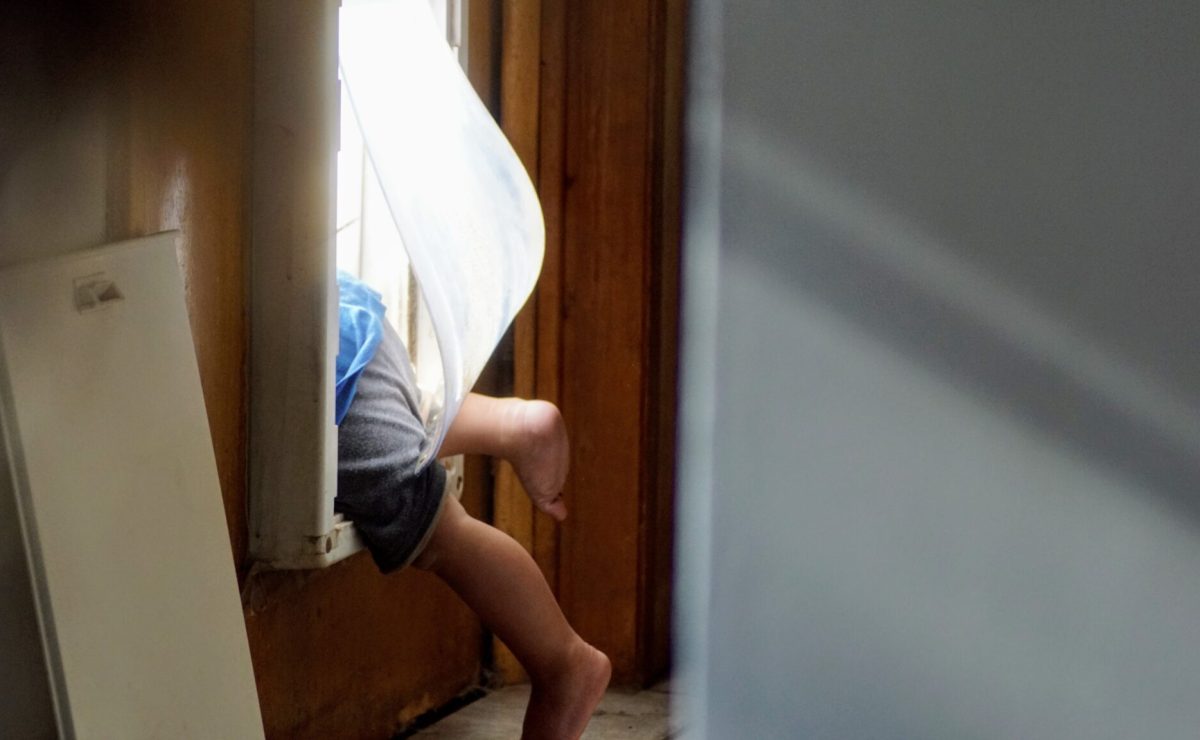Are you a new parent that can’t wait to see your child take their first steps? Well, trust me on this one: enjoy the next few months of relative peace while you can… When your children start walking, they will soon start running, and then they will want to explore the whole world! This exploration includes door knobs and locks!
Of course, learning how to walk is an important milestone in the development of your child, but it also comes with some hazards. In this phase, your child will probably want to open every door and window and see what’s behind them.
It is important to childproof your locks and knobs so that your small child can’t open them without you. This way, you will ensure that your child can’t wander off or access some dangerous areas of your home.
As your child grows up, you won’t have to worry about these things, but until then, you should childproof your doors. There are several methods to do it, such as installing knob covers, safety latches, safety gates, and many more.
This article will be your guide toward a safer home. Here, you will find everything about different door childproofing methods, so keep reading to learn more!
The Top 10 Methods for Childproofing Door Locks and Knobs
These days, we have so many different methods to childproof our door locks and knobs and keep our children safe. For example, there are lever handle locks that prevent your child from grabbing the lever door handles.
There are also round doorknob covers that make it impossible for your child to operate the doorknob. If you have sliding doors, safety latches will prevent your child from opening them. You can also try flip locks or magnetic locking systems.
In total, we will cover 10 methods for door childproofing:
- Lever handle locks
- Door knob covers
- Sliding door safety latches
- Flip locks
- Door stops and pinch guards
- Magnetic locking systems
- Door monkey door locks
- Bi-fold door locks
- Keyless/smart door locks
- Dutch doors and safety gates
Method 1: Lever Handle Locks for Child Safety
If you have any doors with lever door handles, you need to childproof them ASAP. These lever handles can be easily grabbed by small children’s hands, so make sure to install lever handle locks.
Lever handle locks are attached to the door, and they usually consist of one or two parts that prevent the door handle from being pushed down. Basically, they encase the door handle. There is a button accessible by adults only that, once pressed, releases the door handle from the lock.
Before you try this method, keep in mind that this method has both advantages and disadvantages. Its advantages are ease of installation, ease of use, and efficiency. However, these locks aren’t 100% childproof. Sometimes, they won’t fit your door handles, and there is a possibility of door damage.
Method 2: Door Knob Covers to Prevent Unwanted Access
If you have round doorknobs, you should get yourself door knob covers. They also encase the doorknob, disabling the child to get a good grip and open the door. Doorknob covers have holes that allow adults to grab the door knobs and use them as usual.
Of course, this method also comes with some pros, such as ease of installation and the fact that it doesn’t alter your doors permanently. However, it also comes with some cons, as doorknob covers can be hard to use even for adults, and they can crack after prolonged use.
If you choose this childproofing method, make sure to choose the right fit for your doors. These covers should fit perfectly with your doorknobs for maximum safety.
Method 3: Sliding Door Safety Latches
If you have sliding doors in your home, the previous two childproofing methods won’t be enough to keep your child safe. Sliding doors are easy to open, even for small children, and these safety latches will prevent that.
These latches can be installed not only on sliding doors but also on windows. They are easy to use for adults, and they don’t require any permanent alterations to your doors and windows.
The installation process is extremely easy! These latches usually come with strong adhesive strips. You need to clean the surface where you will place the latch. Then peel off the backing paper from the adhesive strip and place the latch where you want.
From time to time, check if the latch is still working properly. Make sure that the adhesive strip is still holding everything in place as it should.
Method 4: Flip Locks for Extra Security
For extra security, you can also install flip locks on your doors. Apart from operating the door handle or a doorknob, one needs to unlock a flip lock to open the door. This is basically an impossible task for small children, which makes flip locks a great addition to your doors.
Flip locks consist of two parts, a flip latch, and a bracket. The bracket should be installed on the door, while the latch should be installed on the door frame. The two parts should fit perfectly when the door is closed.
Flip locks are great for preventing your child from opening doors; they are affordable and easy to install and use. However, they can be hard to handle, especially if there are people with disabilities in your home.
Method 5: Childproof Door Stops and Pinch Guards
There is another reason why doors are dangerous for small children. If your child plays with the open doors, and they suddenly close, a child’s little fingers can get pinched and even broken.
To prevent that from happening, you can install door stops and pinch guards. They will keep the doors from closing abruptly and pinching your child’s fingers. Choose door stops and pinch guards made of durable materials that won’t break easily or damage the door.
When installing these products, make sure they are out of your child’s each. Otherwise, your child might learn how to remove them.
Method 6: Magnetic Locking Systems for Cabinet Door Knobs & Locks
These locking systems are used to childproof various drawers and cabinets. When installed, the magnetic locking system doesn’t allow the cabinet door or drawer to be opened unless one uses a magnetic key.
These locking systems are based on electromagnetic force. When the doors are closed, an electromagnet on the door frame bonds with a plate on the door. This keeps the door locked until you use the special magnetic key that breaks this bond and essentially unlocks the door.
Apart from being cool, this childproofing method is highly efficient, and it automatically locks the cabinets and drawers as you close them. However, in case you lose the keys, you won’t be able to open your cabinets.
Method 7: Door Monkey Door Lock and Pinch Guard
Thanks to its unique design, Door Monkey will prevent your child from shutting the door on its fingers while also preventing it from opening the door. It is attached to the door like the regular pinch guard, but it is also attached to the door frame.
This product is easy to install and use. It has two functions, which is another great thing about it. However, it isn’t compatible with all door types, so make sure to check if your door is compatible before you buy this type of door lock. Additionally, your child might figure out how to remove this door lock, so don’t fully rely on it.
Method 8: Bi-fold Door Locks
If you have bi-fold doors and windows, you can childproof them with specialized locks. These locks can look similar to flip locks, but they can also be more complex. The important thing is that they need to hold your door wings together so that your child can’t open them.
Bi-fold door locks are affordable and easy to install, but they are not compatible with every bo-fold door type. Keep that in mind before opting for this childproofing method.
Method 9: Keyless Door Locks and Smart Locks
In this modern age, technology can help us reach new levels of safety, even when it comes to childproofing our doors. There are keyless door locks and smart locks that need no keys to unlock.
Instead, you use apps and biometrics to operate these locks, and you can even do it remotely. You can also integrate these locks with other smart home devices and even with home security systems, which is another benefit of this method.
However, these locks are not as affordable as other solutions. There is also a question of cyber security and the possibility of getting hacked. And you need to ask yourself if your doors and home are compatible with such technologies.
Before you choose smart and keyless locks, make sure to research different options and service providers thoroughly. You also need to have a backup plan in the case of a power outage.
Method 10: Dutch Doors and Safety Gates
Dutch doors are another great option to restrict access to some dangerous zones inside and outside your home. These doors are divided into two parts, the upper and the lower. You can choose to open just the upper section and leave the lower section closed. That will prevent your small child from exiting the door.
Alternatively, you can install safety gates in narrow hallways, stairways, and other areas of your home. There are several types of safety gates to choose from; some are mounted, while others are flexible.
Dutch doors and safety gates are easy to install and use, and they are usually affordable. However, if your child is a good climber, they might not be a good enough solution for your family.
Customizing Your Childproofing Approach
Now that you learned more about different childproofing methods, you need to decide which one is the best for you. To do that, you should assess your home and figure out what are your specific needs.
Don’t forget that you can combine several different options. You don’t have to choose only one. Also, keep in mind that as your child grows, you need to adapt your childproofing methods. Something that worked yesterday might be inefficient today.
Tips for Using Door Knobs & Locks While Maintaining Safety
Once you choose and install one of these childproofing products, your job is far from over. You need to check regularly if everything is working as it should. Keep an eye out for signs of wear and tear, fix and replace the broken parts, or replace the whole thing.
Finally, you should never fully rely on any product. Always supervise your child, and don’t let them out of your sight for too long. As they grow up, you need to teach them about the dangers and safe behaviors. Only then can you say that you did everything you could for your child’s safety!
Tweak Your Door Knobs & Locks to Keep Your Little Explorer Safe
As soon as your child becomes mobile, they will want to explore your home. Doors will become their obsession, and your job is to reduce the associated hazards. You don’t want your child to go through the door and wander off.
You also don’t want to pinch their little fingers while playing around the door. This is why you need to childproof all the doors and their locks in your home. Figure out which childproofing method suits your needs the best and implement it.
Don’t forget that your child needs to learn about safety as they grow. Supervise them and teach them about the dangers. Don’t neglect that part because you can’t childproof everything forever.

Be aware, and stay safe!
Found this article useful? please share it with your friends!
And to stay up to date with our latest content, don’t forget to follow us on Facebook!




